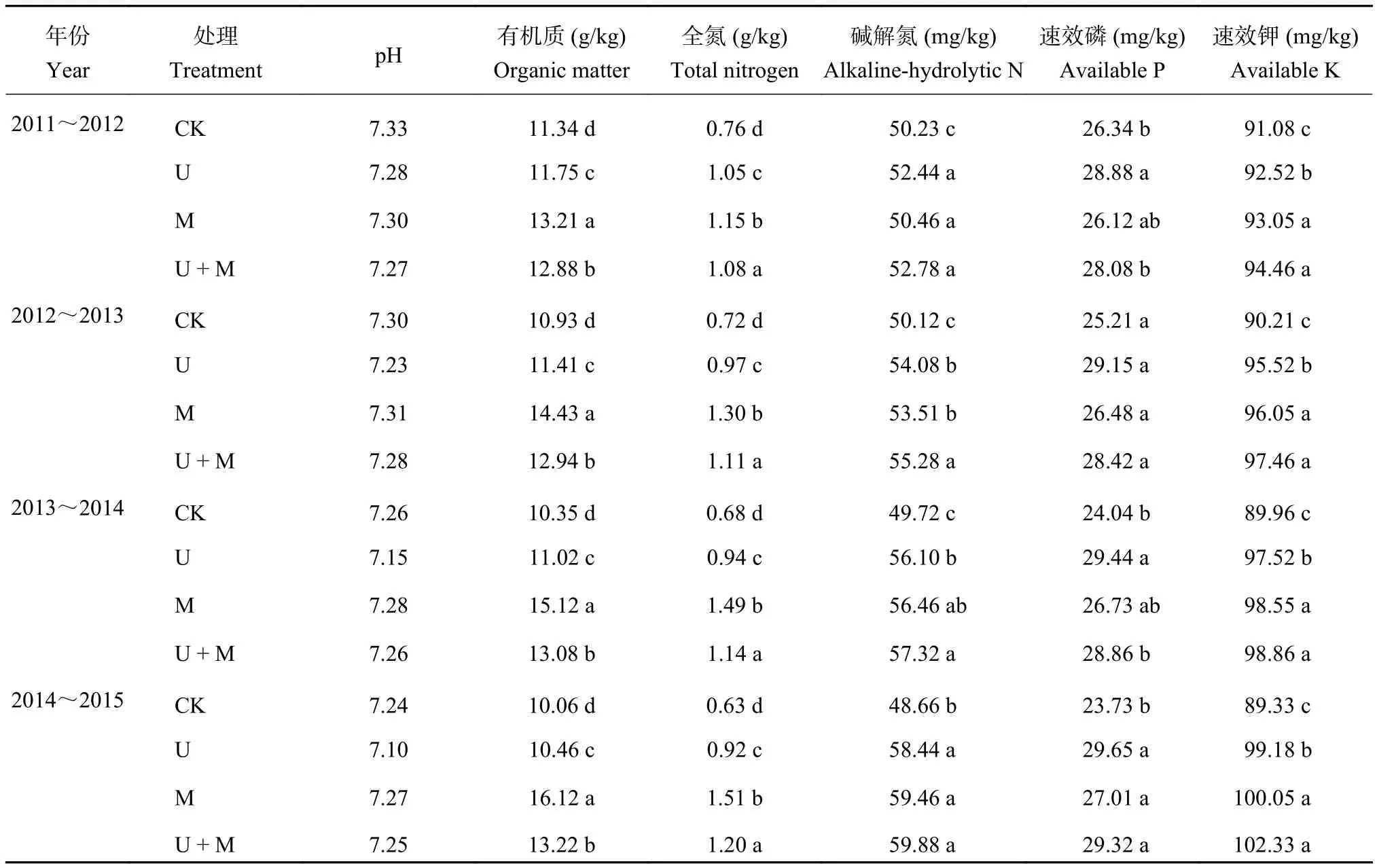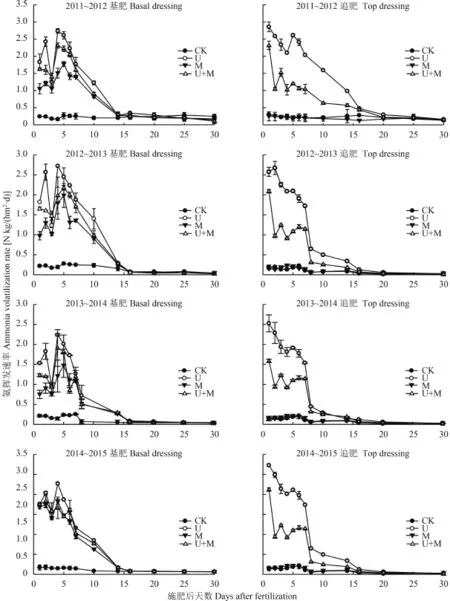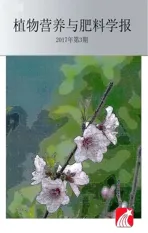长期有机无机肥配施对冬小麦籽粒产量及氨挥发损失的影响
2017-06-13郑凤霞董树亭刘鹏张吉旺赵斌
郑凤霞,董树亭,刘鹏,张吉旺,赵斌
长期有机无机肥配施对冬小麦籽粒产量及氨挥发损失的影响
郑凤霞,董树亭*,刘鹏*,张吉旺,赵斌
(山东农业大学农学院/作物生物学国家重点实验室,山东泰安 271018)
【目的】黄淮海地区作为华北平原重要的农业生产区,氮肥投入量大、利用率低的现象较为普遍,氮肥损失和农业面源污染严重。本研究在长期肥料定位试验基础上,连续多年监测不同施肥处理下冬小麦田氮素挥发损失量及其规律,探讨减少黄淮海地区麦田氨挥发的有效施肥方式,为提高冬小麦产量及肥料利用效率提供科学依据。 【方法】2011~2015 年利用水肥渗漏研究池进行试验,以石麦 15 (SM15) 为材料,以不施氮肥(CK) 为对照处理,在同等施氮量下设置单施尿素 (U)、单施牛粪 (M) 和尿素牛粪 1∶1 配施 (U + M) 3 种氮肥配比处理,随机区组设计。采用通气法连续 4 年原位监测不同施肥处理下小麦氨挥发损失量、小麦籽粒产量及氮肥利用率。 【结果】2011~2015 年氨挥发损失量年际间变化较大,最大变幅可达 19.69 kg/hm2,年际间施肥后氨挥发速率变化规律趋势相似。不同施肥处理对土壤氨挥发有显著影响,冬小麦季氨挥发主要发生在施肥后15 d 内,拔节期追肥的氨挥发速率显著高于播种期施用基肥。四年间氨挥发损失量平均达 7.26~42.40 kg/hm2,与不施氮肥相比,施氮处理的氨挥发损失量升高 1.40~4.84 倍,表明施用氮肥显著促进土壤氨挥发;施氮处理的氮肥损失率以 U 处理最高,达到 19.5%,M 处理最低,为 5.7%,U + M 处理为 12.3%,介于两处理之间,U + M 处理和 M 处理的氮肥损失率较 U 处理四年平均分别降低了 37.0% 和 71.1%,表明单施有机肥或有机无机肥配施可显著抑制氨挥发损失。2011~2015 年各施肥处理冬小麦产量均以 U + M 处理最高,达 9461.5 kg/hm2,较U 和 M 处理分别增产 6.8% 和 9.1%。各处理的冬小麦籽粒吸氮量、地上部吸氮量同样以 U + M 处理最大,较 U和 M 处理分别提高 7.1%、12.6% 和 5.4%、12.9%。U + M 处理的氮肥利用率在四年均最高,达 41.96%,较 U和 M 处理分别提高 16.5%~19.6% 和 38.6%~58.7%。 【结论】综合籽粒产量及氮素利用效率,有机无机肥配施比单施化肥能显著降低氨挥发损失,提高籽粒产量和氮肥利用率,有利于实现冬小麦高产与肥料高效的协同,可作为黄淮海区域小麦生产中的增产增效的优化施肥方式。
有机无机配施;冬小麦;氨挥发;籽粒产量
黄淮海地区作为华北平原重要的农业生产区,种植方式以冬小麦/夏玉米一年两熟制为主,为了追求高产农户往往施用较多化肥,小麦生产过程中氮肥过量施用的现象已相当严重[1–2],而氮肥利用率却仅有 20%~40%[3],未被作物吸收利用的氮素则通过氨挥发、淋洗等途径损失到环境中,由于土壤呈碱性,使氨挥发成为氮肥主要的气态损失途径[4–5],达到施氮量的 9%~40%[6–8]。通过氨挥发进入大气的氮素可随降水等方式回归农田和自然生态系统,造成土体及水体系统富营养化,影响生物多样性[9–10]。因此,探索降低土壤氨挥发、减少氮肥损失、控制面源污染的有效农艺措施是实现冬小麦可持续发展亟需解决的关键问题。
我国有机肥源丰富,每年畜禽粪便资源量可达26.1 × 108t[11]。这些有机肥可就地取材,直接还田,既可解决有机肥堆放问题,又可减少对环境的污染。有机无机肥配施可以使化肥与有机肥在养分供应上优势互补,在提升土壤肥力、增加作物产量、提升肥料利用率等方面效果显著[12–15],是合理利用资源、减少化肥用量、保持作物高产高效的施肥方式。前人关于有机无机肥配施对土壤氨挥发损失的研究已有很多[16–19],但多以 1~2 年短期监测为背景,对田间氨挥发的长期原位监测较少,氨挥发还易受环境条件影响,其损失量的年际间变化趋势及差别不明确。本研究在定位施肥试验的基础上,连续 4 年对黄淮海地区冬小麦有机无机肥配合施用下的氨挥发进行原位监测,研究有机无机肥配施对冬小麦田氨挥发损失、产量和氮肥利用率的影响,旨在为通过合理施肥以协同提高冬小麦产量和氮肥利用率、减肥减排提供科学依据。
1 材料与方法
1.1 试验地概况
田间试验于 2011~2015 年在山东农业大学黄淮海玉米技术创新中心大型水肥渗漏研究池 (36°09′ N,117°09′ E) 进行。所在区域年平均气温 12.8℃,7 月份气温最高,平均 26.4℃,1 月份最低,平均 –2.6℃。年平均降水 697 mm,夏季降水较多,占 65%,冬季较少,仅占 3.6%。无霜期 195 d。种植制度为冬小麦–夏玉米一年两熟制。
水肥渗漏研究池 (2.5 m × 2.5 m × 2.0 m) 由混凝土砌成,每个池子相互独立,底部密封且设有排水口。池子由下往上依次填 15 cm 粗砂、5 cm 细砂和180 cm 土壤,土壤取自附近农田,同层土壤混匀后填入,按照当地习惯种植玉米和小麦预试三年之后开始本研究定位试验。2011~2015 年播种前渗漏池0—20 cm 土层土壤化学性质见表 1。
1.2 试验设计
供试冬小麦品种为石麦 15 (SM15),种植密度为240 × 104株/hm2,每个小区种植 12 行,行距 20 cm。设置 4 个不同施肥方式:不施氮肥 (CK)、单施尿素(U)、单施牛粪 (M) 和尿素牛粪 1∶1 配施 (U + M)。随机区组设计,每个处理设 3 次重复,共 12 个小区。氮肥类型为普通尿素和腐熟的牛粪,尿素中含氮量为 46.0%,过磷酸钙中 P2O5含量 11.2%,硫酸钾中 K2O 含量为 51.1%,每年施入的有机肥料养分含量通过测定得出,具体见表 2。施氮处理的氮水平均为纯 N 180 kg/hm2。各处理的磷钾肥施用量保持相同,均为 P2O5150 kg/hm2和 K2O 150 kg/hm2。若牛粪处理不足 150 kg/hm2,则用过磷酸钙和硫酸钾补齐,若单施牛粪处理中的 P2O5或 K2O 量超过 150 kg/hm2,则其他处理用过磷酸钙和硫酸钾补充至牛粪处理的量。2011~2015 年具体施肥量见表 3。牛粪 (湿基)、过磷酸钙、硫酸钾一次性基施,尿素分基肥和拔节追肥施用,基施和追施 1∶1。施肥方式为基肥播前撒施在地表,翻耕埋入土后播种并立即灌水;追肥在小麦拔节期开沟施用覆盖后灌水。2011~2014 年均于 10 月 10 日播种,田间管理同小麦高产田。

表1 播种前渗漏池 0—20 cm 土层土壤化学性质Table1 Soil chemical properties in 0–20 cm soil layer of the experiment field before sowing

表2 不同生长季有机肥水分、养分含量 (%)Table2 Water and nutrient contents in organic fertilizers in different growing seasons
1.3 测定项目与方法
1.3.1 土壤氨挥发测定 土壤氨挥发的收集及测定参照王朝辉等的通气法[20]。施入氮肥后,第一周每天收集一次样品,第二周每隔 2~3 d 收集一次,之后每隔 5~7 d 收集一次,直到氨挥发速率 (AVR) 降到接近于零并稳定,该过程最多持续 30 d。
田间土壤的氨挥发速率计算公式:
NH3-N [kg/(hm2·d)] = [M/(A × D)]/100
式中:M 为通气法单个装置平均每次测得的氨量(NH3-N, mg);A 为收集装置的截面积 (m2);D 为每次连续收集的时间 (d)。
氨挥发累积量 = ∑(氨挥发速率 × 每次连续收集的时间)
氨挥发肥料损失率 = (施肥处理氨挥发累积量 –不施肥处理氨挥发累积量)/施肥量 × 100%
1.3.2 土样测定 用直径 2 cm 的土钻,多点采集0—20 cm 耕层土壤,形成混合土样。用烘干法测定土壤含水量。pH 值采用 pH 计测定;土壤有机质用水合热重铬酸钾氧化—比色法测定;土壤全氮用凯氏定氮法测定;土壤全磷采用浓硫酸加热消煮—钼酸铵比色法测定;土壤速效钾采用 1 mol/L 醋酸铵溶液浸提—FP6410 型火焰光度计测定[21]。
1.3.3 植株样品测定 成熟期在每个小区取 30~40株长势均匀、具有代表性的小麦植株,按茎、叶、穗轴 + 颖壳和籽粒分样,105℃ 下杀青 30 min,75℃ 烘干至恒重,称干重。小麦植株干样研磨过筛后经浓H2SO4–H2O2联合消煮,消煮液中的植株全氮含量用AA3 型连续流动分析仪 (SEAL Analytical,Germany)测定。
冬小麦成熟期每个小区中部 1 m2收获测产,脱粒并经自然风干后称重,折算成公顷产量。收获时计数穗数和穗粒数,在脱粒后风干的籽粒中随机取样测定千粒重,重复 3 次。

表3 不同施肥处理的具体施肥量 (kg/hm2)Table3 Application amounts of the fertilizers for different nitrogen treatments
1.4 计算方法及统计分析
氮肥利用效率指标根据韩宝文等[22]的计算方法:氮肥利用率 = (施氮区地上部吸氮量 – 不施氮区地上部吸氮量)/施氮量 × 100%;氮素收获指数=籽粒氮素积累量/植株氮素积累量。
所有试验数据采用 Excel 2003 软件计算,用SPSS 20.0 软件进行单因素方差分析,用 LSD 法比较处理间在 P = 0.05 水平上的差异显著性,利用 Sigma Plot 10.0 软件作图。
2 结果与分析
2.1 不同施肥处理对冬小麦季施肥后土壤氨挥发速率的影响
2011~2015 年施用氮肥后冬小麦田间氨挥发速率趋势一致 (图 1),在施用基肥、播种小麦并立即灌水的情况下,各施肥处理均有明显的氨挥发。在最开始的 7 d,各施肥处理的氨挥发速率较高且呈现不规则变化,之后速率逐渐降低。施氮处理在一周内均出现两个峰值,最大峰出现在施肥后 4~5 d,U处理与 U + M 处理最高,分别达 2.23~2.74 kg/(hm2·d) 和 1.91~2.31 kg/(hm2·d),M 处理最低,降低至 1.47~2.14 kg/(hm2·d),U + M 和 M 处理较 U处理分别降低 14.3%~15.7% 和 21.9%~34.1%。第14 d 后与 CK 无显著差异,20 d 后氨挥发速率接近于 0。
与小麦基肥有所不同,追肥并灌溉后氨挥发速率在 1~2 d 即达到峰值,U 处理仍为最高 [2.52~2.85 kg/(hm2·d)],其次为 U + M 处理 [1.58~2.32 kg/(hm2·d)],M 处理的氨挥发速率由于基肥施入的牛粪缓慢释放氮素而维持在一个较低水平,与 CK 处理无显著差异。
2.2 不同施肥处理对冬小麦季施肥后土壤氨挥发损失总量的影响
表4 表明,2011~2015 年,冬小麦生育期内田间氨挥发损失量变化较大,最大变幅可达 19.69 kg/hm2,这可能与不同年份气温等环境因素不同有关。各处理四年的氨挥发损失量平均达 7.26~42.40 kg/hm2,氮肥损失率最高可达 19.52%,是黄淮海平原主要的氮素损失途径。各施肥处理的氨挥发损失总量表现为 U > U + M > M > CK。U 处理四年平均损失量为 42.40 kg/hm2,较 U + M 和 M 处理分别高 44.3% 和 143.4%;施氮量相等的条件下,氨挥发的氮肥损失率表现为 U > U + M > M,与 U 处理相比,U + M 和 M 处理的氨挥发氮肥损失率分别降低了 37.0% 和 71.1%。由表 4 还可看出,在基肥和追肥施氮量相同 (U 处理) 的情况下,追肥时期发生的氨挥发损失显著高于基肥,占全生育期内氨挥发总量的 53.5%。
2.3 不同施肥处理对冬小麦产量及产量构成因素的影响
施氮肥能有效提高冬小麦籽粒产量 (表 5),U + M、U 和 M 处理分别比对照增产 73.9%、62.7% 和59.4%,各施肥处理小麦产量均以 U + M 处理最高,达到 9 175.3~9 781.6 kg/hm2,较 U 和 M 处理分别提高 6.8% 和 9.1%,U 和 M 处理间差异不显著。从产量构成因素分析,有机无机肥配施显著影响冬小麦产量构成因素,四年的数据均显示 U + M 处理和 U处理可获得较高的公顷穗数和穗粒数,其次为 M 处理,CK 处理最低;而千粒重则表现为 CK 和 M 处理较大,其次为 U + M 处理,U 处理最小。综合分析,公顷穗数和穗粒数对提高产量的贡献较大,有机无机配施处理下构成产量的各因素均达较高水平,最终其产量最高。
2.4 不同施肥处理对冬小麦氮素利用效率的影响
由表 6 可以看出,增施氮肥可以显著增加冬小麦籽粒吸氮量和地上部吸氮总量,与对照处理相比,施氮处理小麦籽粒吸氮量增加 33.04~51.19 kg/hm2,地上部总吸氮量提高 32.7%~49.9%。在施用等量氮肥情况下,U + M 处理的籽粒吸氮量显著高于 U 和M 处理,增幅分别达到 7.1% 和 12.6%,在 2011~2015 年 U 处理显著高于 M 处理。各处理的地上部总吸氮量与籽粒吸氮量趋势一致。氮素收获指表现为CK > M > U + M > U,处理间差异不显著。氮肥利用率以 U + M 处理最高,达 40.5%~45.0%,四年平均较 U 和 M 处理分别提高 18.2% 和 52.5%。表明有机无机肥配施可加强冬小麦对氮肥的吸收利用,提高氮肥的有效利用率。
3 讨论
有机肥与无机肥配施,既能使作物高产,又能培肥地力,是实现作物高产高效和促进农业可持续发展的一种有效措施。前人在 1~2 年试验的基础上得出,有机肥与无机肥配合施用能有效降低氨挥发损失[24–26]。刘红梅等[4]于 2006~2007 年进行大田试验,结果表明,华北平原东北部小麦季累计氨挥发量在 5.35~8.92 kg/hm2,且不同施氮水平下的氨挥发损失均以有机无机肥配施较低。本研究连续 4 年的数据均表明,在施氮量 180 kg/hm2的条件下,冬小麦田的氨挥发损失量可达 13.09~52.84 kg/hm2,不同年份间波动幅度最大可达 19.69 kg/hm2。有机无机肥配施能有效降低氨挥发损失,其氨挥发损失量较尿素处理降低 13.02 kg/hm2。究其原因,主要是尿素与有机肥施入土壤后发生的反应不同,尿素在土壤脲酶的作用下被水解成 NH4HCO3,NH4HCO3迅速转化为 NH4+-N,为氨挥发提供较多底物,使尿素处理的氨挥发速率高于其他处理;而有机肥施入土壤后,经过矿化作用将各种形态的有机氮转化为 NH4+-N。NH4+-N 一部分被作物吸收利用,一部分被土壤吸附,剩余部分则大多在土壤 pH 偏碱性的条件下以氨的形式挥发出来[27]。有机无机肥配施之所以能降低土壤氨挥发,原因是有机肥中的有机质在分解过程中大量有机酸被释放同时形成腐殖质,抑制了尿素水解过程中土壤酸碱度的升高,从而显著抑制土壤氨挥发[28]。

图1 2011~2015 年施肥后土壤氨挥发速率Fig. 1 Ammonia volatilization rate after the fertilization in 2011–2015

表4 2011~2015 年冬小麦季基施和追施氮肥后土壤氨挥发累积量、损失率及其占所施氮肥的百分比Table4 Cumulative ammonia volatilization, loss rate and their proportion in the applied nitrogen fertilizer after the basal and top dressing in 2011–2015
合理的有机无机肥配施可以起到显著的增产作用,张建军等[29]在黄土旱塬地研究了有机肥对冬小麦产量的影响,结果表明,氮磷化肥配施生物有机肥较单施化肥增产 17.5%,氮肥配施普通农家肥较单施化肥处理产量提高 3.4%。于昕阳等[30]研究表明,有机无机肥配施与相同施氮量下的单施无机肥处理相比,冬小麦产量提升 1.2%~12.7%。本研究结果同样表明,有机无机肥配施能够显著提高冬小麦产量,各施肥处理在四个生长季均表现为有机无机肥配施处理产量最高,较对照增产幅度达到 73.9%,较单施化肥增产 6.8%。这是由于有机无机肥料配合施用,可以调控土壤氮素的固持和释放,协调土壤氮素供应[31],使肥效相互促进,还可以提高冬小麦群体光合速率[32],增加光合产物的积累。因此,有机无机肥料配施较单施有机肥或单施化肥的增产效果更优。

表5 不同施肥处理下冬小麦产量及产量构成因素 (2011~2015)Table5 Yield and yield components of winter wheat under different fertilizer treatments in 2011–2015
有机无机肥配合施用有利于作物氮肥利用率的提高[33–34]。刘益仁等[35]研究表明有机无机肥配施显著提高了水稻的氮肥利用率,其主要机制为配施促进了土壤微生物的繁殖,协调了土壤氮素释放与作物氮素吸收进程的同步性,较好地满足了水稻生长发育对氮素养分的需求。吴迪等[35]的研究表明,配施有机肥可促进玉米对氮肥的吸收利用,有利于氮素由营养器官向生殖器官的转运,减少氮素损失,从而显著提高氮肥利用率。本研究中有机无机肥配施也提高了冬小麦的氮肥利用率。与单施化肥相比,有机无机肥配施处理的氮肥利用率较单施化肥四年平均提高了 18.2%,主要原因,一是增加了冬小麦对氮素的吸收利用,提高了籽粒的氮素积累量,较单施化肥提高 5.6%~8.3%,二是减少了氮肥的损失,氨挥发作为黄淮海麦区主要的氮肥损失方式,降低氨挥发是提高氮肥利用率的有效途径。
4 结论
长期田间原位监测结果表明,在施氮量为 180 kg/hm2的条件下,不同年份间氨挥发损失波动较大,土壤氨挥发肥料损失率可达 4.5%~22.0%,是黄淮海区域小麦/玉米轮作下的主要氮肥损失形式。有机无机肥 1∶1 配施下可以显著提高冬小麦籽粒产量、吸氮量和氮肥利用率,同时降低氨挥发损失。追肥施用期的氨挥发损失高于基肥施用期,优化追肥的施用对减少氨挥发也起到积极作用。在本试验条件下,综合考虑冬小麦高产、氮素高效利用,化肥与有机肥 1∶1 配施可作为黄淮海区域小麦的绿色增产增效施肥方式,值得倡导与推广。

表6 不同施肥处理下冬小麦吸氮量及氮肥利用效率 (2011~2015)Table6 Nitrogen uptake and nitrogen use efficiency of winter wheat under different fertilizer treatments in 2011–2015
[1]张福锁, 崔振岭, 王激清, 等. 中国土壤和植物养分管理现状与改进策略[J]. 植物学通报, 2007, 24(6): 687–694. Zhang FS, Cui ZL, Wang JQ, et al. Current status of soil and plant nutrient management and improvement strategies in China[J]. Chinese Bulletin of Botany, 2007, 24(6): 687–694.
[2]Ju XT, Kou CL, Christie P. Changes in the soil environment from excessive application of fertilizers and manures to low contrasting intensive cropping systems on the North China[J]. Environmental Pollution, 2007, 145(2): 497–506.
[3]江立庚, 曹卫星. 水稻高效利用氮素的生理机制及有效途径[J]. 中国水稻科学, 2002, 16(3): 261–264. Jiang LG, Cao WX. Physiological mechanism and approaches for efficient nitrogen utilization in rice[J]. Chinese Journal of Rice Science, 2002, 16(3): 261–264.
[4]刘红梅, 庞凤梅, 赖欣, 杨殿林. 供氮水平和有机无机配施对麦田土壤氨挥发的影响[J]. 安徽农业科学, 2012, 40(12): 7119–7122, 7249. Liu HM, Pang FM, Lai X, Yang DL. Effects of nitrogen fertilizer rate and combined application of organic manure and chemical fertilizer on soil ammonia volatilization in winter-wheat field[J]. Journal of Anhui Agricultural Sciences, 2012, 40(12): 7119–7122, 7249.
[5]朱兆良. 农田中氮肥的损失与对策[J]. 土壤与环境, 2000, 9(1): 1–6. Zhu ZL. Loss of fertilizer Nfrom plant-soil system and the strategies and techniques of its reduction[J]. Soil and Environmental Sciences, 2000, 9(1): 1–6.
[6]Ma BL, Wu TY, Tremblay N, et al. On-farm assessment of the amount and timing of nitrogen fertilizer on ammonia volatilization[J]. Agronomy Journal, 2010, 102(1): 134–144.
[7]宋勇生, 范晓辉. 稻田氨挥发研究进展[J]. 生态环境学报, 2003, 12(2): 240–244. Song YS, Fan XH. Summary of research on ammonia volatilization in paddy soil[J]. Ecology and Environment Sciences, 2003, 12(2): 240–244.
[8]田光明, 蔡祖聪, 曹金留, 李小平. 镇江丘陵区稻田化肥氮的氨挥发及其影响因素[J]. 土壤学报, 2001, 38(3): 324–332. Tian GM, Cai ZC, Cao JL, Li XP. Ammonia volatilization of nitrogen fertilizers and its affecting factors in paddy fields of Zhenjiang hilly region[J]. Acta Pedologica Sinica, 2001, 38(3): 324–332.
[9]Fillery IR P, Vlek PL G. Reappraisal of the significance of ammonia volatilization as aN loss mechanism in flooded rice fields[J]. Nutrient Cycling in Agroecosystems, 1986, 9(1–2): 79–98.
[10]Tian GM, Cao JL, Cai ZC, Ren LT. Ammonia volatilization from wheat field top-dressed with urea[J]. Pedosphere, 1998, 8(4): 331–336.
[11]张夫道, 张俊清, 赵秉强, 等. 无公害农产品市场准入及相关对策[J]. 植物营养与肥料学报, 2002, 8(1): 3–7. Zhang FD, Zhang JQ, Zhao BQ, et al. Safety control and its related strategy for market entry of green farm produce[J]. Plant Nutrition and Fertilizer Science, 2002, 8(1): 3–7.
[12]Krupa SV. Effects of atmospheric ammonia (NH3) on terrestrial vegetation: a review[J]. Environmental Pollution, 2003, 124(2): 179–221.
[13]Chauhan SS, Bhatnagar RK. Influence of long term use of organic and inorganic manures on soil fertility and sustainable productivity of wheat in Vertisols of Madhya Pradesh[J]. An Asian Journal of Soil Science, 2014, 9(1): 113–116.
[14]Duan YH, Xu MG, Gao SD, et al. Nitrogen use efficiency in a wheat–corn cropping system from 15 years of manure and fertilizer applications[J]. Field Crops Research, 2014, 157(2): 47–56.
[15]Zhang HM, Xu MG, Shi XJ, et al. Rice yield, potassium uptake and apparent balance under long-term fertilization in rice-based cropping systems in southern China[J]. Nutrient Cycling in Agroecosystems, 2010, 88(3): 341–349.
[16]郁洁, 蒋益, 徐春淼, 等. 不同有机物及其堆肥与化肥配施对小麦生长及氮素吸收的影响[J]. 植物营养与肥料学报, 2012, 18(6): 1293–1302. Yu J, Jiang Y, Xu CM, et al. Effects of combined application of inorganic fertilizer with straw and pig slurry and their compost on wheat growth and nitrogen uptake[J]. Plant Nutrition and Fertilizer Science, 2012, 18(6): 1293–1302.
[17]倪康, 丁维新, 蔡祖聪. 有机无机肥长期定位试验土壤小麦季氨挥发损失及其影响因素研究[J]. 农业环境科学学报, 2009, 28(12): 2614–2622. Ni K, Ding WX, Cai ZC. Ammonia volatilization from soil as affected by long-term application of organic manure and chemical fertilizers during wheat growing season[J]. Journal of Agro-Environment Science, 2009, 28(12): 2614–2622.
[18]郝小雨, 高伟, 王玉军, 等. 有机无机肥料配合施用对日光温室土壤氨挥发的影响[J]. 中国农业科学, 2012, 45(21): 4403–4414. Hao XY, Gao W, Wang YJ, et al. Effects of combined application of organic manure and chemical fertilizers on ammonia volatilization from greenhouse vegetable soil[J]. Scientia Agricultura Sinica, 2012, 45(21): 4403–4414.
[19]俞映倞, 薛利红, 杨林章. 太湖地区稻田不同氮肥管理模式下氨挥发特征研究[J]. 农业环境科学学报, 2013, 32(8): 1682–1689. Yu YL, Xue LH, Yang LZ. Ammonia volatilization from paddy fields under different nitrogen schemes in Tai Lake region[J]. Journal of Agro-Environment Science, 2013, 32(8): 1682–1689.
[20]王朝辉, 刘学军, 巨晓棠, 张福锁. 田间土壤氨挥发的原位测定—通气法[J]. 植物营养与肥料学报, 2002, 8(2): 205–209. Wang ZH, Liu XJ, Ju XT, Zhang FS. Field in situ determination of ammonia volatilization from soil: Venting method[J]. Plant Nutrition and Fertilizer Science, 2002, 8(2): 205–209.
[21]鲁如坤. 土壤农业化学分析方法[M]. 北京: 中国农业科技出版社, 2000. Lu RK. Methods of soil agricultural chemical analysis [M]. Beijing: China Agricultural Science and Technology Press, 2000.
[22]韩宝文, 王激清, 李春杰, 刘社平. 氮肥用量和耕作方式对春玉米产量、氮肥利用率及经济效益的影响[J]. 中国土壤与肥料, 2011, (2): 28–34. Han BW, Wang JQ, Li CJ, Liu SP. Impacts of nitrogen application rates and tillage modes on yield, nitrogen use efficiency of spring maize and economic benefit[J]. Soil and Fertilizers Sciences in China, 2011, (2): 28–34.
[23]Gu LM, Liu TN, Wang JF, et al. Lysimeter study of nitrogen losses and nitrogen use efficiency of Northern Chinese wheat[J]. Field Crops Research, 2016, 188: 82–95.
[24]李宗新, 王庆成, 刘开昌, 等. 不同施肥模式下夏玉米田间土壤氨挥发规律[J]. 生态学报, 2009, 29(1): 307–314. Li ZX, Wang QC, Liu KC, et al. Law of field soil ammonia volatilization in summer maize under different fertilizer patterns[J]. Acta Ecologica Sinica, 2009, 29(1): 307–314.
[25]张惠, 杨正礼, 罗良国, 等. 黄河上游灌区稻田氨挥发损失研究[J].植物营养与肥料学报, 2011, 17(5): 1131–1139. Zhang H, Yang ZL, Luo LG, et al. Study on the ammonia volatilization from paddy field in irrigation area of the Yellow River[J]. Plant Nutrition and Fertilizer Science, 2011, 17(5): 1131–1139.
[26]Shang QY, Gao CM, Yang XX, et al. Ammonia volatilization inChinese double rice-cropping systems: a 3-year field measurement in long-term fertilizer experiments[J]. Biology and Fertility of Soils, 2014, 50(5): 715–725.
[27]刘学军, 巨晓棠, 张福锁. 基施尿素对土壤剖面中无机氮动态的影响[J]. 中国农业大学学报, 2001, 6(5): 63–68. Liu XJ, Ju XT, Zhang FS. Effect of basal application of urea on inorganic nitrogen in soil profile[J]. Journal of China Agricultural University, 2001, 6(5): 63–68.
[28]Dong WX, Hu CS, Zhang YM, Cui JF. Ammonia volatilization from urea incorporation with wheat and maize straw on aloamy soil in China[A]. The Proceedings of the International Plant Nutrition Colloquium XVI[C]. Davis: Department of Plant Sciences, University of California, Davis, 2009.
[29]张建军, 樊廷录, 王勇, 等. 有机肥对陇东黄土旱塬冬小麦产量和土壤养分的调控效应[J]. 西北植物学报, 2009, 29(8): 1656–1662. Zhang JJ, Fan TL, Wang Y, et al. Winter wheat yield and soil nutriments affected by organic fertilizer in loess plateau east of Gansu[J]. Acta Botanica Boreali-Occidentalia Sinica, 2009, 29(8): 1656–1662.
[30]于昕阳, 翟丙年, 金忠宇, 等. 有机无机肥配施对旱地冬小麦产量、水肥利用效率及土壤肥力的影响[J]. 水土保持学报, 2015, 29(5): 320–324. Yu XY, Zhai BN, Jin ZY, et al. Effect of combined application of organic and inorganic fertilizers on winter wheat yield, water and fertilizer use efficiency and soil fertility in dryland[J]. Journal of Soil and Water Conservation, 2015, 29(5): 320–324.
[31]梁斌, 赵伟, 杨学云, 周建斌. 长期不同施肥对旱地小麦土壤氮素供应及吸收的影响[J]. 中国农业科学, 2012, 45(5): 885–892. Liang B, Zhao W, Yang XY, Zhou JB. Effects of long-term different fertilization managements on changes of Nin soil and its uptake by wheat on dryland[J]. Scientia Agricultura Sinica, 2012, 45(5): 885–892.
[32]赵隽, 董树亭, 刘鹏, 等. 有机无机肥长期定位配施对冬小麦群体光合特性及籽粒产量的影响[J]. 应用生态学报, 2015, 26(8): 2362–2370. Zhao J, Dong ST, Liu P, et al. Effects of long-term mixed application of organic and inorganic fertilizers on canopy apparent photosynthesis and yield of winter wheat[J]. Chinese Journal of Applied Ecology, 2015, 26(8): 2362–2370.
[33]Bandyopadhyay KK, Misra AK, Ghosh PK, Hati KM. Effect of integrated use of farmyard manure and chemical fertilizers on soil physical properties and productivity of soybean[J]. Soil and Tillage Research, 2010, 110(1): 115–125.
[34]孟琳, 王强, 黄启为, 等. 猪粪堆肥与化肥配施对水稻产量和氮效率的影响[J]. 生态与农村环境学报, 2008, 24(1): 68–71, 76. Meng L, Wang Q, Huang QW, et al. Effects of combined application of pig manure compost and inorganic fertilizers on yield of rice grains and nitrogen use efficiency[J]. Journal of Ecology and Rural Environment, 2008, 24(1): 68–71, 76.
[35]刘益仁, 李想, 郁洁, 等. 有机无机肥配施提高麦–稻轮作系统中水稻氮肥利用率的机制[J]. 应用生态学报, 2012, 23(1): 81–86. Liu YR, Li X, Yu J, et al. Mechanisms for the increased fertilizer nitrogen use efficiency of rice in wheat-rice rotation system under combined application of inorganic and organic fertilizers[J]. Chinese Journal of Applied Ecology, 2012, 23(1): 81–86.
[36]吴迪, 黄绍文, 金继运. 氮肥运筹、配施有机肥和坐水种对春玉米产量与养分吸收转运的影响[J]. 植物营养与肥料学报, 2009, 15(2): 317–326. Wu D, Huang SW, Jin JY. Effects of nitrogen fertilizer management, organic manure application and bed-irrigation sowing on maize yield, and nutrient uptake and translocation[J]. Plant Nutrition and Fertilizer Science, 2009, 15(2): 317–326.
Effects of combined application of manure and chemical fertilizers on ammonia volatilization loss and yield of winter wheat
ZHENG Feng-xia, DONG Shu-ting*, LIU Peng*, ZHANG Ji-wang, ZHAO Bin
( College of Agronomy, Shandong Agricultural University/State Key Laboratory of Crop Biology, Tai’an, Shandong 271018, China )
【Objectives】The Huang Huai-Hai Plain (HHP) is an important agricultural production area in North China Plain. The excessive application of nitrogen fertilizers and low nitrogen use efficiency are very common, and nitrogen fertilizer loss and agricultural non-point source pollution are serious. To deal with these problems, the amount of ammonia volatilization loss and its regularity in winter wheat fields under different fertilization treatments were monitored continuously for many years using along-term fertilization experiment. The purpose ofthis study aimed to reduce the ammonia volatilization of the HHP, and then provide ascientific basis for improving yield of winter wheat and efficiency of fertilizers based on the long-term fertilizer experiment.【Methods】The experiment was conducted using lysimeters in 2011–2015 and the tested winter wheat cultivar was SM15. The venting method was used to monitor ammonia volatilization under four fertilization modes (organic manure, M; half organic manure plus half chemical Nfertilizer, U + M; urea, U and no N fertilizer, CK) in awinter wheat and summer maize rotation in the North China Plain. 【Results】The amount of ammonia volatilization varied greatly from 2011 to 2015, with the maximum value of 19.69 kg/hm2. The trend of ammonia volatilization rate after the fertilization was similar. The ammonia volatilization in winter wheat mainly occurred within 15 days after the fertilization, and the rate of ammonia volatilization after applying topdressing fertilizer at the jointing stage was significantly higher than that at the seeding stage. The flux of ammonia volatilization was dramatically influenced by fertilizer types and their combination. The amount of ammonia volatilization was 7.26–42.40 kg/hm2. The ammonia volatilization loss amounts of the Nfertilizer treatments were increased by 1.40–4.84 times compared with the no Nfertilizer, which indicated that the application of nitrogen fertilizer could significantly promote the ammonia volatilization in the soil. The rate of N loss was the highest in the Utreatment, reaching to 19.5%, that of the Mtreatment was the lowest, reducing to 5.7%, and that of the U+ M treatment was in amiddle position which was 12.3%. The rates of nitrogen fertilizer loss in the U+ M treatment and the Mtreatment were decreased by 37.0% and 71.1% for four years compared with the Utreatment, respectively, which indicated that the combined application of organic manure and nitrogen fertilizer could significantly inhibit ammonia volatilization. The yield of winter wheat of the U+ M treatment was 9461.5 kg/hm2, which was 6.8% and 9.1% higher than those of the Uand Mtreatments, respectively. The nitrogen uptake by grain and absorption of nitrogen in aboveground part of the U+ M treatment were also greater, which were 7.1%, 12.6% and 5.4%, 12.9% higher than the Uand Mtreatments, respectively. The nitrogen use efficiency of the U+ M treatment was the highest in four years, reaching to 41.96%, which was increased by 16.5%–19.6% and 38.6%–58.7% compared with the Uand Mtreatments, respectively. 【Conclusions】Integrating the grain yield and nitrogen use efficiency, the combined application of organic manure and chemical fertilizers could significantly reduce ammonia volatilization loss and increase grain yield and nitrogen use efficiency, and could achieve synergistic effect of high yield and fertilizer efficiency. Therefore, it can be used as an optimum fertilization method for wheat production in Huang-Huai-Hai region.
organic manure and chemical fertilizers; wheat; ammonia volatilization; grain yield
2016–11–15 接受日期:2017–02–08
国家自然科学基金项目(31071358,30871476);国家 “十二五” 科技支撑计划(2013BAD07B06-2);国家现代农业产业技术体系建设项目(CARS-02-20);公益性行业(农业)科研专项(HY20121203100,HY1203096);山东省财政支持农业重大应用技术创新课题(2014)资助。
郑凤霞(1991—),女,山东莱芜人,硕士研究生,主要从事小麦高产与施肥研究。E-mail:zhengfengxia1991@163.com
* 通信作者 Tel:0538-8245838,E-mail:stdong@sdau.edu.cn;Tel:0538-8241485,E-mail:liupengsdau@126.com
